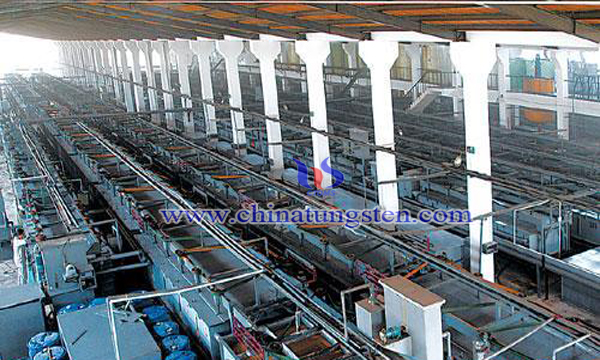Residual Alkali Recovery from Tungsten Smelting
- Details
- Category: Tungsten Information
- Published on Friday, 08 November 2019 23:31
Scheelite is a troublesome raw material in tungsten smelting. After the popularization of alkaline pressure leaching technology in the last century, the smelting capacity and scale of scheelite have been greatly improved, and the technology and process have been further mature. Due to the use of excessive alkali process, although a large part of alkali is consumed in the leaching process, the amount of residual alkali in the crude sodium tungstate solution is still very high after the reaction.

The recovery of residual alkali in tungsten smelting is a process of solution evaporation, concentration and crystallization, mainly energy consumption. However, due to the current situation of rising energy price, most tungsten smelting enterprises will not consider the recovery of residual alkali, after all, the economic benefit is very small. Only when the concentration of residual alkali in the solution is above 100 g / L, the recovery of residual alkali is necessary. The brief process of recovery of residual alkali is as follows:
The feed solution of sodium tungstate from the autoclave contains 100g / L of tungsten trioxide, 45g / L of sodium hydroxide, and 5000ML of solution volume. After liquid-solid separation through the filter press, it is pumped into the three effect evaporation crystallizer. The steam pressure at the inlet of the first effect evaporation crystallizer is 0.4MPa, and the temperature is 155 ℃. The sodium tungstate crystal separated from the two effect evaporation crystallizer and the three effect evaporation crystallizer is sent to the plate and frame filter press for solid-liquid separation. The filtrate is returned to the pressure boiling process, the residue is dissolved and sent to the ion exchange process, and the condensate is used as the dilution water of the main process. The concentration of sodium hydroxide in the filtrate is 385 g / L and that of tungsten trioxide is 25.5g/l. The recovery of tungsten and alkali is 97% and 96.8%, respectively.
The technical points of the above process are as follows: in the crude sodium tungstate solution with low residual alkali concentration, a large amount of water vapor in the solution must be evaporated. After further concentration, the solubility of sodium tungstate in high alkali decreases rapidly and crystal precipitation occurs after the alkali concentration is increased. As the concentration continues, the viscosity of the solution increases. Therefore, in the design layout of the three effect evaporation crystallizer, the two effect and three effect crystallizers will vacuum, which can effectively reduce the boiling point temperature of the solution. Although the temperature of the first effect regeneration steam is lower than that of the raw steam, it can also achieve the purpose of further concentration of the solution. As the solubility of sodium tungstate decreases with the increase of alkali concentration, independent crystal discharge ports are set in the two-way and three-way evaporating crystallizers, so as to prevent scaling and tube resistance due to a large number of crystal precipitation in the two-way crystallizers.
- Tungsten Manufacturer & Supplier, Chinatungsten Online: www.chinatungsten.com
- Tungsten News & Prices of China Tungsten Industry Association: www.ctia.com.cn
- Molybdenum News & Price: news.molybdenum.com.cn
- Tel.: 86 592 5129696; Fax: 86 592 5129797; Email: sales@chinatungsten.com



 sales@chinatungsten.com
sales@chinatungsten.com